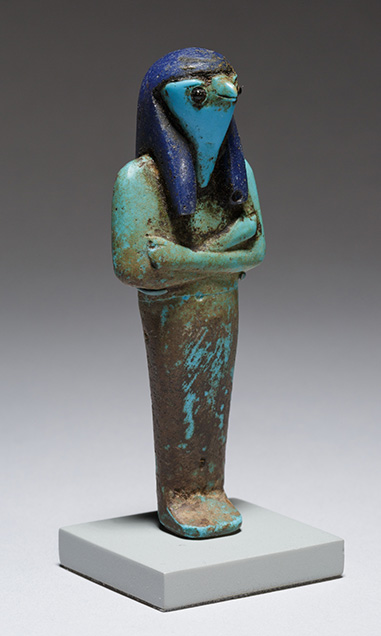Qebehsenuef
Qebehsenuef or Kebehsenuf (in ancient Egyptian: imsti) is one of the four sons of Horus, along with Hapy, Duamutef, and Imsety.
Qebehsenuef is usually portrayed with the head of a falcon. In a funerary context, he was responsible for protecting the intestines of mummified people. As ruler of one of the four cardinal directions, Qebehsenuef was associated with the west.
Name
The name Qebehsenuef means "He who purifies his brother by means of libation."
Origin
Qebehsenuef and the other sons of Horus appear in the earliest known writings concerning the ancient Egyptian religion, the Pyramid Texts. A passage in the later Coffin Texts from the Middle Kingdom (2055–1650 BC) says they are the offspring of the goddess Isis and a form of Horus known as Horus the Elder.
He was governed by the goddesses Serqet or Renenutet (depending on the period and source).
In the Book of the Dead from the Papyrus of Ani, Qebehsenuef says: "I am thy son, O Osiris Ani, triumphant. I have come to protect thee. I have collected thy bones, and I have gathered together thy members. I have brought thy heart and I have placed it upon its throne within thy body. I have made thy house to flourish after thee, O thou who livest for ever."
When Qebehsenuef was invoked on coffins, he was situated by the right foot, on the southwest corner.
Canopic jar
Canopic jars were containers used by the ancient Egyptians during the mummification process, to store and preserve the viscera of their soul for the afterlife. Each of Horus's sons were responsible for protecting a particular organ, was himself protected by a companion goddess, and represented a cardinal direction.
Qebehsenuef protected the intestines, which was extracted from the body, mummified separately, and placed inside his jar. In some later tombs, these jars were merely symbolic and did not contain the actual organs.
Role
Although Qebehsenuef is most prominently found in funerary context as a canopic jar, he is possibly more closely associated with the Egyptian decans. Dutch Egyptologist Maarten Raven argues that the four sons originated as celestial deities, given that the Pyramid Texts frequently connect them with the sky and that Horus himself was a sky deity.
All four sons of Horus are connected with specific decans, ruling over them in some capacity, although the precise nature of their connection is not presently understood by scholars.
According to Cult of the Stars by occultist Travis McHenry, Qebehsenuef rules over the following decans:
Protector of Sah
Some funerary texts state that the four sons of Horus were responsible for preventing Set, in his form as the foreleg of an ox, from reaching the decanal star Sah. Sah was often equated to Osiris, who Set was responsible for murdering.
One theory suggests the four sons of Horus are actually four stars in the constellation Ursa Major, which was known to the ancient Egyptians as msxtyw, the Foreleg of Set. This asterism contained a total of seven stars, and these four would have been located in the "meaty" part of the thigh. In an astronomical context, these four stars formed a border between the southern sky and the northern sky, thereby drawing a barrier between Set and Sah (the constellation Orion).
In this context, Qebehsenuef is theorized to be the star Megrez (Delta Ursae Majoris).
